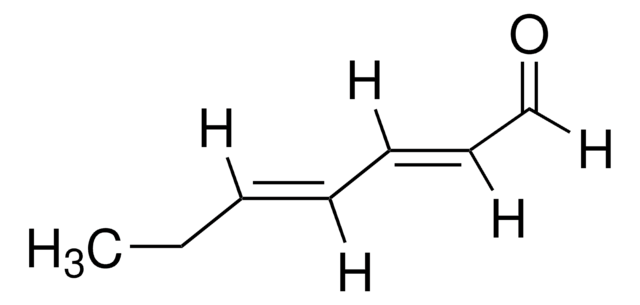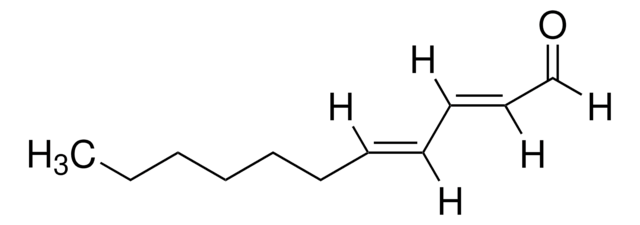Kluczowe dokumenty
W316407
trans,trans-2,4-Heptandienal
≥88%
Synonim(y):
2,4-Heptadienal
Wybierz wielkość
213,00 zł
Wybierz wielkość
About This Item
213,00 zł
Polecane produkty
pochodzenie biologiczne
synthetic
Poziom jakości
klasa czystości
Halal
Kosher
Próba
≥88%
współczynnik refrakcji
n20/D 1.534 (lit.)
bp
84-84.5 °C (lit.)
gęstość
0.881 g/mL at 25 °C (lit.)
Zastosowanie
flavors and fragrances
Dokumentacja
see Safety & Documentation for available documents
alergen pokarmowy
no known allergens
Organoleptyczne
fatty; green; oily; vegetable
ciąg SMILES
CC\C=C\C=C\C=O
InChI
1S/C7H10O/c1-2-3-4-5-6-7-8/h3-7H,2H2,1H3/b4-3+,6-5+
Klucz InChI
SATICYYAWWYRAM-VNKDHWASSA-N
Szukasz podobnych produktów? Odwiedź Przewodnik dotyczący porównywania produktów
Powiązane kategorie
Oświadczenie o zrzeczeniu się odpowiedzialności
Hasło ostrzegawcze
Danger
Zwroty wskazujące rodzaj zagrożenia
Zwroty wskazujące środki ostrożności
Klasyfikacja zagrożeń
Acute Tox. 3 Dermal - Acute Tox. 4 Oral - Skin Irrit. 2
Kod klasy składowania
6.1C - Combustible acute toxic Cat.3 / toxic compounds or compounds which causing chronic effects
Klasa zagrożenia wodnego (WGK)
WGK 3
Temperatura zapłonu (°F)
143.6 °F - closed cup
Temperatura zapłonu (°C)
62 °C - closed cup
Środki ochrony indywidualnej
Eyeshields, Faceshields, Gloves, type ABEK (EN14387) respirator filter
Wybierz jedną z najnowszych wersji:
Masz już ten produkt?
Dokumenty związane z niedawno zakupionymi produktami zostały zamieszczone w Bibliotece dokumentów.
Active Filters
Nasz zespół naukowców ma doświadczenie we wszystkich obszarach badań, w tym w naukach przyrodniczych, materiałoznawstwie, syntezie chemicznej, chromatografii, analityce i wielu innych dziedzinach.
Skontaktuj się z zespołem ds. pomocy technicznej





